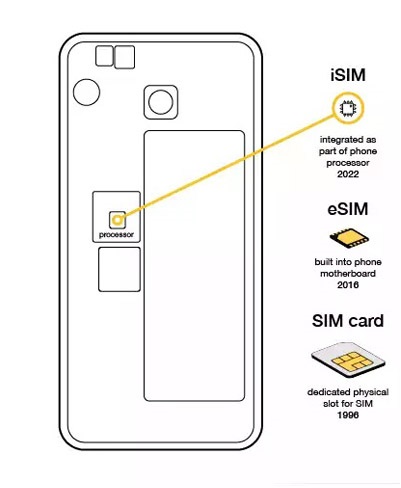SIM (Subscriber Identity Module) is a reliable method of identifying users, checking the authenticity of endpoint devices, and securing their data.
? Over the years, SIMs have shrunk from the original plastic card to Mini-SIM, Micro SIM, and finally Nano-SIM.
Regardless of the packaging, all SIMs are built on smart card (UICC) technology similar to bank cards. The UICC (Universal Integrated Circuit Card) is a secure computing chip that contains memory and provides identification services.
? Note:
– Traditional SIM cards have the operator-defined profile programmed during manufacture.
– There are some limitations for the SIMs, like Size, Physical security, and Cost.
? eSIM: Embedded SIM, is an evolution of the SIM card designed to address the limitations of traditional SIMs. eSIMs are typically physical SIMs that are soldered (a permanent fitting in the device) into the device and enable storage and remote management of multiple network operator profiles (remote SIM provisioning).
? The main benefits of eSIM are:
- Seamless global connectivity: Networks can be switched easily and without physical handling, anywhere in the world
- Size as eSIMs are about half the size of Nano SIMs and don’t require a socket, they easily fit in very small devices,
- Physical security A SIM soldered within a closed device is hard to locate, remove, and reuse.

? iSIM: integrated SIM, is a specification standardized by the GSMA, and is a technical standard that integrates communication modules and SIM functions into a single cellular SoC (System on a Chip).
?The iSIM saves space in hardware design. Every square millimeter matters when it comes to size-constrained applications. Since it does not require physical space for an eSIM chip or removable SIM card, the iSIM can reduce the footprint of a device. That makes iSIM more suitable for #IoT devices, LTE-M and NB-IoT
? So What is the difference between SIM/eSIM and iSIM?
SIM/eSIM has a dedicated physical interface mounted on a secure IC, which is an independent module and is equipped with a SIM OS and other components. On the other hand, iSIM is equivalent to conventional SIM/eSIM by installing SIM OS in a secure physical area (TRE: Tamper Resistant Element) with tamper resistance performance in cellular SoC without using an independent module.
